
Table of Contents
Unveiling the Canvas: Interior Color Schemes
Interior Color Scheme – Embarking on the journey of interior design is akin to painting a masterpiece on a blank canvas. Among the myriad choices, color selection stands as a pivotal decision, dictating the ambiance and personality of a space. Interior color schemes transcend mere aesthetics; they embody emotions, evoke memories, and reflect individuality. In this comprehensive guide, we delve deep into the realm of interior color schemes, exploring how to infuse personality into your space through the artful manipulation of color.
Setting the Stage: Understanding Color Psychology
Before delving into the intricacies of color schemes, it’s imperative to grasp the fundamentals of color psychology. Colors have the remarkable ability to influence mood, behavior, and perception. Warm tones like reds and oranges exude energy and passion, while cool hues such as blues and greens evoke a sense of calm and tranquility. Understanding the psychological effects of colors empowers you to curate an environment that resonates with your desired ambiance and personality.
Harmonious Symphony: Exploring Color Theory
At the heart of interior color schemes lies the principles of color theory, guiding the harmonious blending of hues to create visually appealing spaces. The color wheel serves as a valuable tool, categorizing colors into primary, secondary, and tertiary hues. Complementary colors, situated opposite each other on the wheel, create dynamic contrasts, while analogous colors, adjacent on the wheel, offer subtle harmony. By mastering the art of color theory, you unlock endless possibilities for crafting cohesive and captivating interiors.
The Power of Contrast: Incorporating Accent Colors
In the realm of interior design, contrast serves as a powerful tool for adding depth and visual interest to a space. Accent colors, strategically introduced amidst a dominant color scheme, inject vibrancy and personality into the environment. Whether through bold furniture pieces, statement artworks, or decorative accents, judicious use of accent colors enlivens the space and underscores its unique character. However, moderation is key to prevent overwhelming the senses and maintain balance within the design composition.
Diving into Depth: Monochromatic Elegance
Embracing the simplicity of a monochromatic color scheme offers a timeless approach to interior design. Derived from a single base hue, monochromatic palettes explore various shades, tints, and tones to create a sophisticated interplay of light and shadow. This nuanced approach to color allows for seamless transitions between elements, fostering a sense of cohesion and serenity within the space. From soft neutrals to rich jewel tones, monochromatic interiors exude understated elegance and refined sophistication.


Balancing Act: Achieving Symmetry with Analogous Colors
Analogous color schemes, characterized by hues adjacent to each other on the color wheel, offer a harmonious balance of warmth and unity. By selecting colors within the same family, albeit with varying intensities, you can achieve a cohesive and visually pleasing palette. Analogous schemes are particularly effective in creating a sense of continuity throughout interconnected spaces, such as open floor plans or adjoining rooms. Whether opting for earthy tones or vibrant primaries, analogous color schemes provide a versatile canvas for expressing your personal style.
Bold Statements: Embracing Contrasting Complements
For those daring to make a statement, contrasting complementary color schemes offer a bold and dynamic approach to interior design. By pairing colors situated opposite each other on the color wheel, such as blue and orange or purple and yellow, you create a visually striking juxtaposition that demands attention. Contrasting complements inject vitality and drama into the space, making them ideal for focal points or accent walls. However, exercise caution to maintain balance and avoid overwhelming the senses, opting for subtle accents to temper the vibrancy of the palette.
Nature’s Palette: Drawing Inspiration from the Outdoors (Interior Color Scheme)
Nature has long served as a boundless source of inspiration for interior designers, offering an array of captivating color palettes derived from the natural world. From the serene blues of the sky to the earthy browns of the forest floor, nature’s palette encompasses a diverse spectrum of hues and textures. Drawing inspiration from nature allows you to bring the outdoors indoors, creating spaces imbued with a sense of tranquility and connection to the environment. Whether through botanical motifs, organic materials, or earthy color schemes, embracing nature’s palette infuses your space with warmth and vitality.
Personal Touch: Reflecting Individuality through Color
Ultimately, the most compelling interiors are those that reflect the unique personality and preferences of their inhabitants. While trends may come and go, your personal connection to color remains constant. Whether drawn to soothing neutrals, vibrant primaries, or eclectic mixes of hues, your color choices should resonate with your individuality and lifestyle. Don’t be afraid to experiment, mix, and match colors to create a space that feels truly yours. After all, the essence of interior design lies in the ability to transform a house into a home, infused with the warmth and character of its occupants.
Conclusion: Painting Your Perfect Picture
In the artful tapestry of interior design, color serves as the brushstroke that brings spaces to life. By understanding the principles of color psychology, mastering the nuances of color theory, and embracing your personal preferences, you can craft interiors that transcend mere aesthetics, reflecting your unique personality and style. Whether opting for monochromatic elegance, analogous harmony, or contrasting drama, the possibilities are as boundless as your imagination. So, dare to dream in color and embark on a journey of self-expression through the transformative power of interior color schemes.


